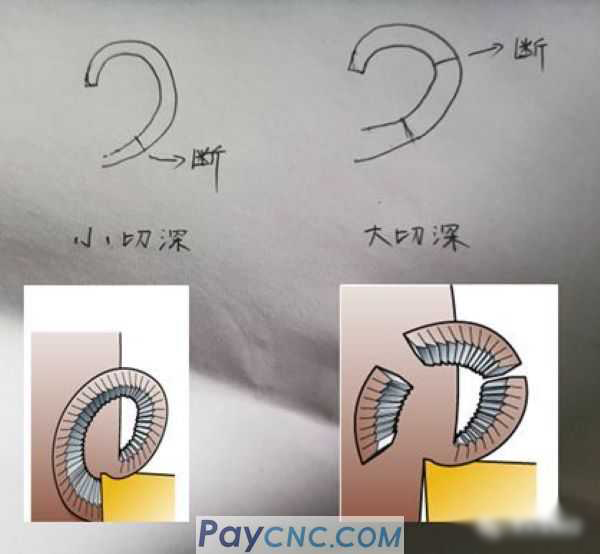We often encounter many problems in the turning process, for example, the chips wrap around the workpiece, wrap the tool, affect the surface finish of the workpiece, affect the processing efficiency, and even the subsequent processes are difficult to proceed.
Then once you keep crumbing,
How to do it?
Look at the picture below:

This is the relationship between cutting parameters and iron filings
Vertical axis: represents the depth of cut Ap
Horizontal axis: represents the feed amount F
Specifically, the depth of cut (Ap) and feed rate (F) can directly affect the shape of the iron filings
why?
Come, look at the picture below

The picture on the left is a small depth of cut, the one on the right is a large depth of cut
After increasing the cutting depth, the iron filings will become thicker
Then under the same degree of curvature, thick iron filings will easily break
Increasing the feed rate means increasing the depth of cut in the axial direction. The reason is the same, so I won't draw the picture.
The reason is as simple as that:
Under the same degree of curvature of iron filings, thick iron filings will easily break
Then, if iron filings continue:
1. Increase the depth of cut Ap
2. Increase the feed rate F
You can solve most of the chip breaking problems if you use these two 2 tricks well.
Of course, in many cases the depth of cut cannot be adjusted. The main thing is to adjust the feed rate (it is better to reduce the speed S and increase the F, so as to increase the tool life). But too much feed will bring corresponding problems. You need to pay attention to the following two points:
Problem 1: The cutting force becomes larger
Increased requirements for the strength of the entire processing system may cause vibration. If the vibration occurs, it will not work. You have to think of other ways. (For details, please refer to the article I shared earlier on solving tool vibration)
Problem 2: Decreased finish
In the case of the same rounded corners, the smoothness will definitely decrease if the feed is increased, so pay attention to the smoothness of the workpiece.
(There is an empirical formula for the relationship between fillet and feed: Ra=(f*f**50)/re, the larger the feed, the smaller the tool tip fillet, and the greater the surface roughness value obtained)
|
 |
| Products Catalogue | Home | About Us | Retrofit | Download | News | Tech Support | Contact Us | |
|
|
|
